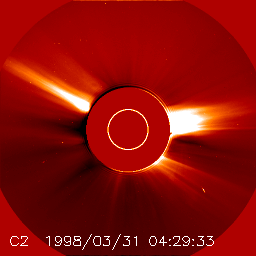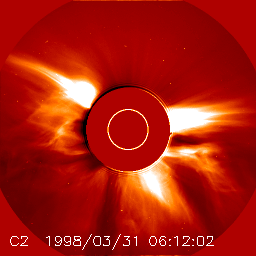
Hi, my name is Mark and I'm going to tell you about the explosive nature of the Sun and about about some special comets called sun-grazers.
The Sun is surrounded by an atmosphere of extremely hot gas called the Corona. Gas in this very hot state is called plasma.
The image below shows a typical view of this atmosphere as seen by LASCO (Large Angle Spectrometric Coronagraph, partially built at Birmingham!), one of the instruments onboard SoHO.

The white circle in the centre marks the position of the Sun's surface (called the photosphere). The large orange circle is part of the instrument. It blocks light coming directly from the Sun's surface. Without this we wouldn't be able to see the very dim Corona.
In this image you see that most of the gas is concentrated into long bright features called streamers. To get a feel for how far into space these streamers stretch compare them with the size of the Sun.
(MAYBE HAVE A DIAGRAM HERE TO COMPARE SIZE OF EARTH WITH STREAMERS)
In this image all looks quiet and steady. What do you think happened next? Click on ? to find out.
 **(THIS IMAGE AND THE PARAGRAPH BELOW WOULD BE HIDDEN UNTIL THEY CLICK ON IT)
**(THIS IMAGE AND THE PARAGRAPH BELOW WOULD BE HIDDEN UNTIL THEY CLICK ON IT)
BOOM!!! Here we see a picture taken about two hours after the one above. What you see is a huge explosion from the Sun's atmosphere. However this is no ordinary explosion. It is triggered low down in the Sun's atmosphere and the force of the explosion blows millions of tons of material (electrons and protons) into space at very high speeds.
Follow the links below to learn some more.
-------
IMAGE 3
-------
The Corona is made up of very small dust grains and charged particles, like electrons and protons. Most of the light we see coming from the Corona, as in the picture above, really comes from Sun's surface. This light gets scattered or re-directed by the dust and electrons in the Sun's atmosphere, some of it coming in the direction of the Earth. In this way we can see the Corona. However there is a catch. The light that comes to us from the Sun's surface is much brighter than the scattered light from the Corona. Normally this glare hides the Corona from our view.
**(PUT IN A CARTOON SHOWING HOW CORONA SCATTERS LIGHT)
A similar thing happens with a candle flame for instance. In a darkened room the flame looks quite bright. However in daylight it looks less bright. This is because the daylight is brighter than the flame and swamps the light from the candle.
So how do we get over this problem? Simple, we block the light that comes directly from the Sun, using a special telescope called a coronagraph. This instrument places a disk in front of the Sun and only allows light from the Corona to pass through. This reveals the Corona in all its glory.
Of course there is a natural process that acts like a coronagraph -- A total solar eclipse! During such an eclipse like the one that will happen in August 1999 the moon moves in front of the Sun. This blocks the light coming directly from the Sun and the corona becomes visible as a shining glow around the moon. The appearance of the Corona during an eclipse gave rise to its name -- Corona means crown. During an eclipse the Sun's atmosphere surrounds the moon like a crown.
------------- ECLIPSE PHOTO ------------- ------- ------- ------- IMAGE 4 C1 IMAGE 5 C2 IMAGE 6 C3 ------- ------- -------
LASCO is an instrument on SoHO that was designed to look at the corona. It consists of three coronagraphs which give us three views of the Sun's atmosphere from near the surface to far out into space. With LASCO we can view the Corona extending out to 30 times the radius of the Sun -- that's about 13 million miles!
**(POSSIBLY PUT IN A QUESTION ASKING TO GUESS HOW FAR 30 SOLAR RADII ARE WHICH THEY CAN CLICK ON AND GET THE ANSWER)
Before the invention of coronagraphs people had to wait until a total solar eclipse to see the Corona. Now we can view it whenever we like and because of instruments like LASCO we can get a much better view!
The temperature at the centre of the Sun is about 15 million K. As you move outwards through the different layers of the Sun the temperature drops to about 6000 K at the Sun's surface. This is what you would expect from everyday experience. For example the further you stand from a fire the cooler it feels. So we might expect that the atmosphere of the Sun above the surface would be cooler than 6000 K. However the surprize is that its much hotter -- about 1 to 2 million degrees!
One of the main reasons for studying the Corona is to find out why it's so hot and what keeps it so hot. It now seems that the magnetic field of the Sun plays a large part in heating the Corona.
This magnetic field is also responsible for CMEs, which are often accompanied by other solar activity like flares or prominences. CMEs were first discovered in the 1970s when spaceborne coronagraphs were first launched. There are several reasons we are interested in them.